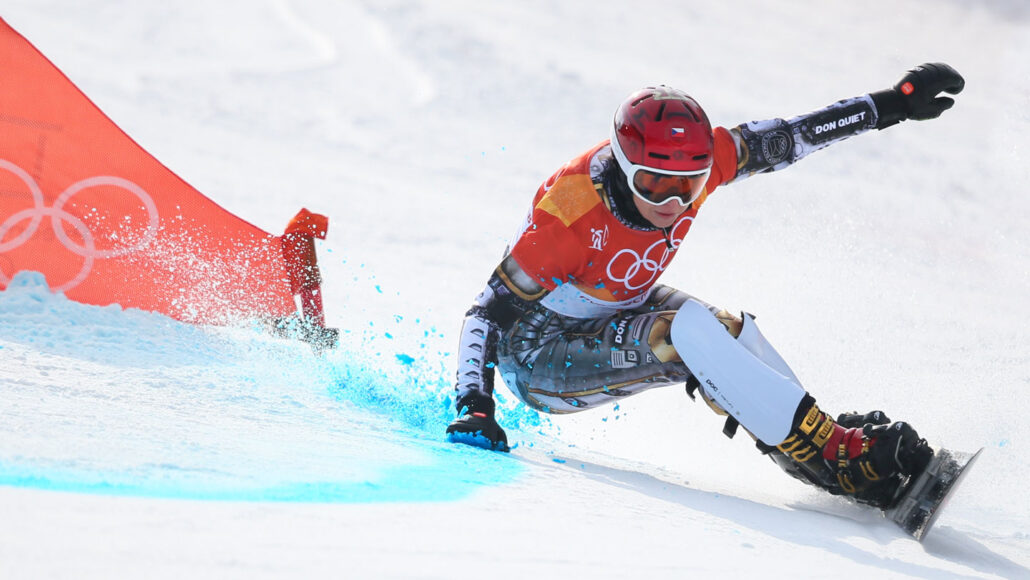Let’s learn about the science of the Winter Olympics
From scientific innovations to climate change, there’s plenty of science among the sport

Snowboarders, skiers and other athletes are gearing up to compete in the 2022 Winter Olympics in Beijing, China. Scientific advances may give some competitors an edge, but climate change threatens the very future of these games.
Laurent Salino/Agence Zoom/Stringer/Getty Images
In just a few days, athletes from around the world will compete in the Winter Olympics in Beijing, China. The Olympic games are a spectacle of speed and grace. Curlers deftly nudge stones into place. Figure skaters whip themselves into fancy twirls on the balance of a blade. Snowboarders ride rails and launch off of ramps into daring flips and twists. Every Olympian has trained for years to show off their skills on the world stage.
In contests between such elite athletes, tiny details can make the difference between silver and gold. The chemistry of ski wax, for instance, affects how well skis glide across or grip snow. The recipe can make or break a skier’s performance. In bobsledding, meanwhile, shoe stiffness is key. Just the right amount of bendiness can give athletes the boost of speed they need to take first place.
But there’s one key piece of Winter Olympic equipment no one can totally control: cold weather. Without it, athletes like skiers and snowboarders can’t compete. Unfortunately, many cities may soon be too warm to host the Winter Olympics. The reason: human-caused climate change. If it doesn’t get cold enough, snow can’t fall. In fact, this is the first Winter Olympics ever that will completely depend on artificial, rather than natural, snow. That could become the norm in the future.
Some technology does exist to coax clouds into making more snow. This weather-control technology helped create clear skies at the Beijing Summer Olympics in 2008. But tampering with the weather may have unintended consequences. And it still won’t produce enough snow to keep the slopes covered.

Educators and Parents, Sign Up for The Cheat Sheet
Weekly updates to help you use Science News Explores in the learning environment
Thank you for signing up!
There was a problem signing you up.
Want to know more? We’ve got some stories to get you started:
Olympic ski racers use chemistry to enhance their performance The chemistry of ski wax plays an important role in whether an Olympic skier wins or loses. (2/12/2018) Readability: 6.0
In bobsledding, what the toes do can affect who gets the gold South Korean scientists have been developing shoes that could give their national bobsled team an advantage at the Olympics. (2/21/2018) Readability: 6.6
Climate change threatens future Winter Olympics Higher temperatures and less snow may make many former Winter Olympics sites unfit to host future games. (2/9/2018) Readability: 8.3
Explore more
Explainer: CO2 and other greenhouse gases
Why many Olympic athletes have early birthdays
What happened when Simone Biles got the twisties at the Olympics?
Athletes’ head injuries can provoke surprisingly long-lasting harm
Is weather control a dream or a nightmare?
Football and hockey don’t necessarily doom players’ brains to serious damage
Even some Olympic athletes cheat with drugs
Why Paralympic sprinters have trouble with curves
Why sports are becoming all about numbers — lots and lots of numbers
New spray gel moves drugs deep to treat frostbite
Activities
Blend sport and art with these Winter Olympic crafts. Create a toy figure skater that glides around a metal canister through the power of magnetism. Use ice cubes to play a mini game of curling in the bathtub. Or, race marble “lugers” down a paper plate track.







